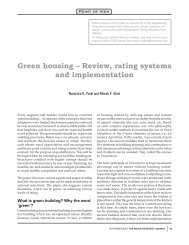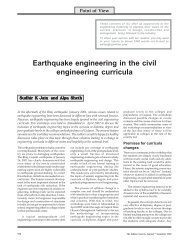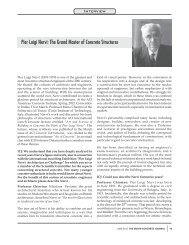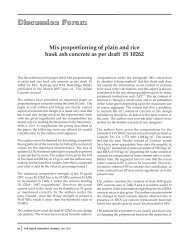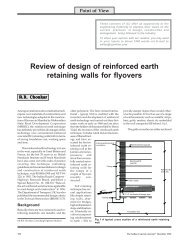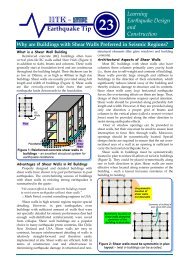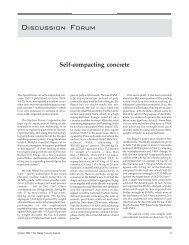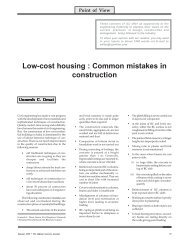Download - The Indian Concrete Journal
Download - The Indian Concrete Journal
Download - The Indian Concrete Journal
You also want an ePaper? Increase the reach of your titles
YUMPU automatically turns print PDFs into web optimized ePapers that Google loves.
or multistage) and agitation time in each<br />
stage. <strong>The</strong>re are no IS codes which<br />
specify guidelines on the mixing<br />
method for concrete and hardly any<br />
published specification is available on<br />
this subject. However, research work<br />
indicates that mixing method has<br />
influence on the properties of concrete<br />
mixes including HVFAC mix 19 .<br />
<strong>The</strong>refore, selection of appropriate<br />
mixing method is important for optimal<br />
utilisation of HVFAC.<br />
<strong>The</strong> acceptance criteria of any<br />
concrete mix is specified in terms of 28<br />
days cube compressive strength, refer<br />
Table 11 of IS 456. It is seen from the<br />
results mentioned in references and<br />
those results published in different<br />
literature that gain in strength and<br />
reduction in rapid chloride permeability<br />
test (RCPT) value of fly ash concrete<br />
from the age of 28 days to 56 days and<br />
beyond are substantial 3,6,7,8,9,10 .<br />
Moreover, no structure or structural<br />
component is subject to designed<br />
service condition at the age of 28 days.<br />
<strong>The</strong>refore, acceptance criteria based on<br />
28 days would lead to non-utilisation<br />
of all advantages of HVFAC. It is<br />
suggested to define the acceptance<br />
criteria based on 56 days properties or<br />
more. Canadian code A23.1-04 has<br />
already specified such acceptance<br />
criteria 18 . However, every care is to be<br />
taken to ensure that the mix gains<br />
requisite strength to withstand the effect<br />
of construction activities after the<br />
minimum period necessary for curing,<br />
that is, 14 days or after stripping of<br />
shuttering, whichever is earlier.<br />
Curing<br />
HVFAC mix has low w/b ratio that<br />
causes less bleeding resulting in<br />
potential risk of plastic shrinkage cracks<br />
if curing is not started as early as<br />
possible. This calls for initial curing,<br />
which should be started immediately<br />
after placing of concrete. No IS codes<br />
covers specification of initial curing and<br />
reference – 20 addresses initial curing<br />
of silica fume incorporated HPC in<br />
detail. Approaches suggested there<br />
have been found suitable for HVFAC.<br />
Covering surfaces with impervious<br />
sheet or applying curing compounds as<br />
in the case for concrete pavements are<br />
efficient methods for initial curing.<br />
After final setting of concrete, water<br />
20<br />
Point of View<br />
curing should be commenced.<br />
Specification of IS 456 is sufficient for<br />
this purpose 13 .<br />
Conclusion<br />
Based on the above discusion, following<br />
conclusions can be drawn.<br />
(i) Existing IS codes are suitable for<br />
characterisation of concrete<br />
ingredients for HVFAC. Major<br />
observations on IS 3812 (Part - I and<br />
II) : 2003 specifications for<br />
characterisation of fly ash are,<br />
(a) <strong>The</strong> standard specifies<br />
suitable requirements for<br />
characterisation of fly ash.<br />
Requirement mentioned about<br />
average fineness is not<br />
necessary and may be deleted.<br />
(b) Most important requirement<br />
for characterisation of fly ash<br />
is to restrain the LOI to 5<br />
percent.<br />
(ii) IS codes impose limitation of 35<br />
percent on the maximum usage of<br />
fly ash in Portland pozzolana<br />
cement but there exists no<br />
limitation on the quantity of fly ash<br />
in concrete mix, if it is mixed<br />
separately in site batching.<br />
(iii) HVFAC should be produced in<br />
mechanised batching plant or RMC<br />
plant under necessary quality<br />
control. Target strength for<br />
developing HVFAC or any<br />
concrete mix produced by<br />
mechanised mixer need not be<br />
fixed at characteristic strength plus<br />
1.65 times standard deviation. A<br />
conservative estimate of target<br />
strength is 1.2 times the<br />
characteristic strength for mix not<br />
leaner than grade M30.<br />
(iv) From the point of view of economy,<br />
HVFAC should be characterised<br />
for 56-day strength. However, the<br />
mix should have required strength<br />
for construction purpose after the<br />
minimum period required for<br />
curing, that is, 14 days.<br />
(v) Neither IS code nor codes of any<br />
other country provides guidelines<br />
on mixing method of HVFAC.<br />
Published work on this subject<br />
suggests mixing method has<br />
influence on the performance of<br />
HVFAC and other types of concrete<br />
mixes.<br />
(vi) HVFAC should be cured in two<br />
stages. Initial curing is dry curing<br />
for which no specification is<br />
available in any IS code. However,<br />
specification of IS 456 on wet<br />
curing is adequate.<br />
References<br />
1. MEHTA, P.K. and MONTEIRO, P.J.M., <strong>Concrete</strong> –<br />
Microstructure, Properties and Materials, First<br />
international edition, <strong>Indian</strong> <strong>Concrete</strong> Institute,<br />
1997.<br />
2. BASU, PRABIR C., High performance concrete:<br />
mechanism and application, ICI <strong>Journal</strong>, April-<br />
June 2001, Vol. 2, No. 1, <strong>Indian</strong> <strong>Concrete</strong><br />
Institute, pp. 15-26.<br />
3. BASU, PRABIR C., SARASWATI, SUBHOJIT, High<br />
volume fly ash concrete with <strong>Indian</strong><br />
ingredients, <strong>The</strong> <strong>Indian</strong> <strong>Concrete</strong> <strong>Journal</strong>,<br />
March 2006, Vol. 80, No. 3, pp. 37-48<br />
4. BASU, PRABIR C., NPP Containment Structures:<br />
<strong>Indian</strong> Experience in Silica Fume Based HPC,<br />
<strong>The</strong> <strong>Indian</strong> <strong>Concrete</strong> <strong>Journal</strong>, October 2001,<br />
Vol. 75, No.10, pp. 656-664.<br />
5. MAVINKURVE, SHREETI, BASU, PRABIR, C. and<br />
KULKARNI, V.R., High performance concrete<br />
using high reactivity metakaolin, <strong>The</strong> <strong>Indian</strong><br />
<strong>Concrete</strong> <strong>Journal</strong>, May 2003, Vol. 77, No. 5, pp.<br />
1077-1085.<br />
6. FOURNIER, B., LU., D., CHARLAND, J.P. and LI, J.,<br />
Evaluation of <strong>Indian</strong> fly ashes for use in HVFA<br />
<strong>Concrete</strong>s - Part I: Characterisation, <strong>The</strong> <strong>Indian</strong><br />
<strong>Concrete</strong> <strong>Journal</strong>, November 2004, Vol. 78,<br />
No. 11, pp. 22-30.<br />
7. SIVASUNDARAM, V., Evaluation of <strong>Indian</strong> fly<br />
ashes for the HVFA concrete - Part II:<br />
Behaviour in <strong>Concrete</strong>, <strong>The</strong> <strong>Indian</strong> <strong>Concrete</strong><br />
<strong>Journal</strong>, November 2004, Vol. 78, No. 11, pp.<br />
41-50.<br />
8. DESAI, J., Construction of HVFA concrete<br />
pavements in India: Four case studies, <strong>The</strong><br />
<strong>Indian</strong> <strong>Concrete</strong> <strong>Journal</strong>, November 2004, Vol. 78,<br />
No. 11, pp. 67-71.<br />
9. ASHRAF, M., SHARMA, AMIT and MOKAL, MANISH,<br />
HVFA <strong>Concrete</strong> for tremie seal and pylon pile<br />
cap of Bandra-Worli sea link project, <strong>The</strong> <strong>Indian</strong><br />
<strong>Concrete</strong> <strong>Journal</strong>, November 2004, Vol. 78,<br />
No. 11, pp. 31-36.<br />
10. SHETTY, M.S., SEETHARAMAIAH, R.V., REDDY, S.A.,<br />
PAI, B.V.B. and KAUSHIK, S.K. High strength<br />
cement – State of the art report, International<br />
Symposium on Innovative World of <strong>Concrete</strong>,<br />
Bangalore, India, 1993.<br />
11. ______Pulverised fuel ash – specification, Part-1:<br />
for use as pozzolana in cement, cement mortar and<br />
concrete, IS 3812 (Part 1) : 2003, Bureau of <strong>Indian</strong><br />
Standards, New Delhi, India.<br />
12. ______Pulverised fuel ash – specification, Part-2:<br />
for use as admixture in cement, mortar and concrete,<br />
IS 3812 (Part 2): 2003, Bureau of <strong>Indian</strong><br />
Standards, New Delhi, India.<br />
<strong>The</strong> <strong>Indian</strong> <strong>Concrete</strong> <strong>Journal</strong> * August 2006






